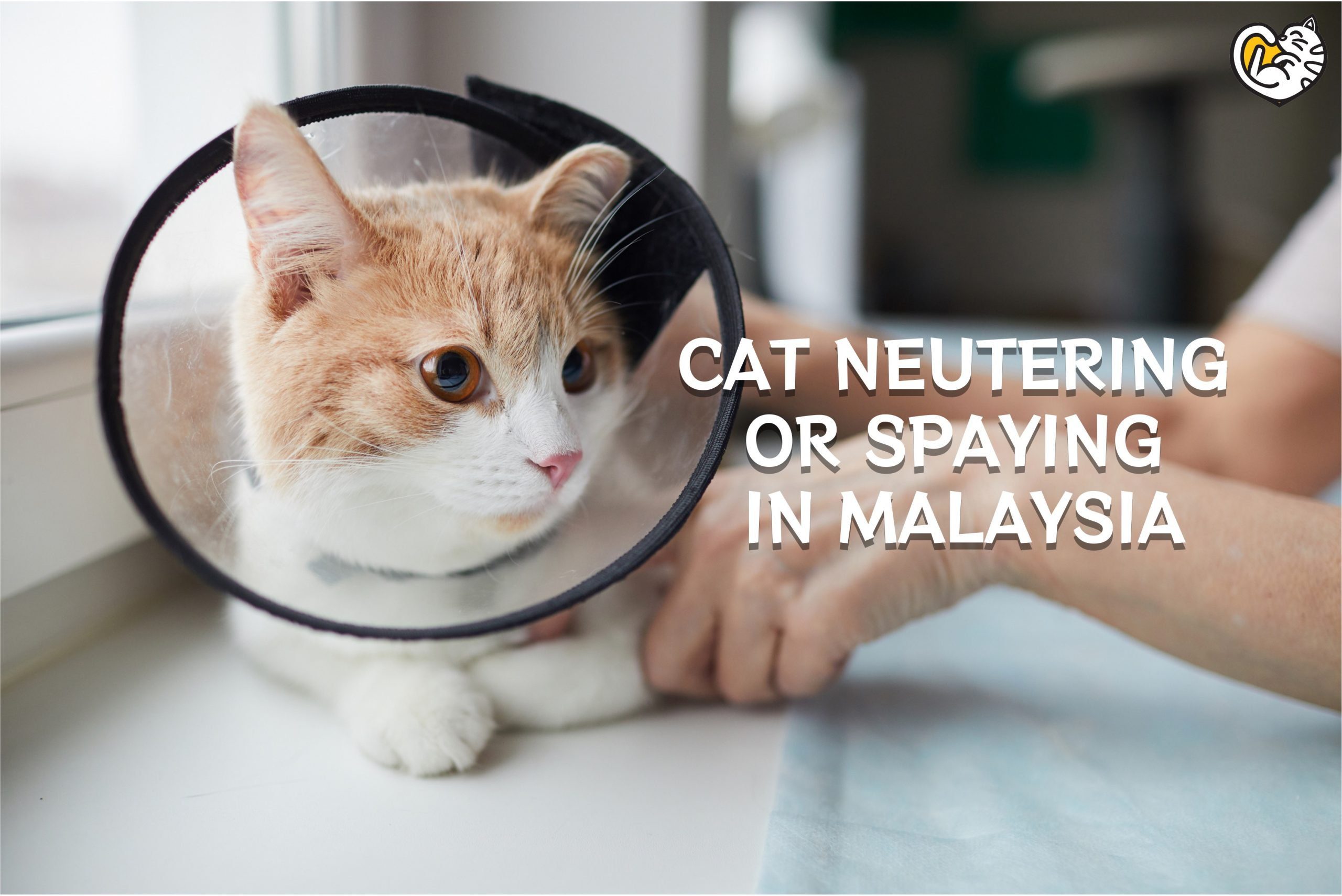Cat Neutering or Spaying in Malaysia


There are millions of stray cats around the world that suffer lives of misery, such as starvation, disease, cold and abuse. Just like other countries, Malaysia also struggles with stray cats. It's no secret that stray animal is an issue in Malaysia, which is why many people choose to have their pets spayed or neutered. In this article, we will answer some of the important questions about cat neutering or spaying in Malaysia.
Is Your Cat Picky About Food?
Well, my cats used to be like that too, but now they finished the food all the time!
If your cat doesn’t want to eat the food or finish the food you gave, I have a solution for you. Read my true story here.
What Are Cat Neutering and Spaying?
The term “neutering” and "spaying" are often misunderstood; however, they are simply another name for sterilisation. “Neutering” and “spaying” are commonly used by veterinarians to describe the surgical practice of removing an animal's reproductive organs. The inability to reproduce and give birth to offspring is the result of spaying or neutering a pet.
Neutering is the castration of male animals and is the complete removal of their testicles, while spaying refers to the removal of the ovaries and uterus in female cats. These procedures are commonly used to avoid unwanted litter and to help reduce pet overpopulation.
Why Should I Have My Male Cat Neutered?
Neutering a male cat is a great way to help it develop into a loving, well-adapted pet. The major reasons to neuter your cat include the following:
• Neutering helps in the reduction of cat overpopulation. It's difficult to agree, but there aren't enough homes for the cats that need to be adopted right now. This is because every year, thousands of cats enter shelters because there are more cats born than there are homes for them.
• It reduces wandering in male cats. A healthy male cat will do almost anything to find a mate, this includes running away from home. Wandering can cause your cat to get into fights with other animals, get lost or stolen, or get hit by a car.
• Neutering your cat increases its chances of living a healthier and longer life. This is because male cats who are neutered are less likely to get certain diseases such as testicular cancer, prostate problems and pancreatic cancer.
• Neutering stops the generation of testosterone. This hormone causes behaviours related to sexual maturity, such as aggressiveness between housemates and spraying urine in your house for territory-marking.
Why Should I Have My Female Cat Spayed?
Spaying is often known as an Ovariohysterectomy. A spayed female cat won't be able to reproduce and won't experience heat cycles. The following are some of the reasons you should spay your female cats:
• It helps fight against cat overpopulation: Spaying your cats can help with the overpopulation problem and minimise the number of stray cats who end up in shelters rather than loving homes.
• Less urge to roam: Cat that has been spayed no longer feels the need to wander in search of a mate. As a result, they stay at home and are less likely to be involved in traumatic accidents like getting struck by a car. They are also less likely to get into fights and have a lower risk of catching communicable infections.
• Your female cat will live a healthier and longer life: Spaying prevents breast cancer and uterine infections, which is deadly in 90% of cats. The best prevention against these diseases is to spay your cat before its first heat, which is around five months of age.
• The cost of spaying your cat is much less than the cost of having and caring for a litter. Also, as it reduces the chance of them wandering off and getting into fights with other animals, this saves you the cost of a possibly life-threatening injury.
How Much Does Neutering or Spaying a Cat Cost in Malaysia?
Generally, the cost of neutering is cheaper than the cost of spaying a cat in Malaysia because the latter’s surgery is more complicated. Neutering a male cat usually costs about RM120- RM180 while spaying a female cat costs RM150-RM250, depending on the clinic. Some animal welfare organisations such as SPCA do offer low-cost spay and neuter program, which is about RM100 for male and RM120 for female.
What Is the Best Age to Neuter or Spay a Cat?
We recommend spaying or neutering cats around the age of five months. This is due to the fact that cats can reach sexual maturity as early as four to six months of age, so you should sterilise your cat before that. Some of the benefits of neutering or spaying your cat at earlier ages are as follows:
• Studies have found that kittens sterilised at younger ages have lesser surgical complications and recover more quickly. The surgery itself is also faster and less complicated than spaying a cat in heat or pregnant.
• Reduces the risk of some types of cancer in female cats. Research shows that a female cat spayed before her first heat cycle has a 91% lower risk of developing mammary gland cancer.
• Neutered cats tend to be more sociable and easier to train, and training should begin while the cat is young.
• It prevents hormone-related behaviours such as regular nuisance due to excessive noise from a female cat when she is in heat, which is very loud.
Should I Neuter or Spay My Cat After Heat?
Most veterinarians recommend spaying or neutering your cat before its first heat cycle. This is the best time to do it because it helps reduce the cat's health hazards even more. Spaying your female cat before the first heat can help avoid uterine infections, breast cancer and uterus cancer. Male cats who are neutered are less likely to get testicular cancer and have prostate issues. Spayed and neutered cats, on the whole, live healthier, longer and happier lives.
If the cat reaches reproductive maturity before spaying, there may be residual hormones after the procedure. These hormones can cause a cat to continue certain sexual related behaviours for a short time. Levels of this hormone should decline over the weeks following surgery, gradually eliminating the cat's sexual desire.
Can I Spay a Cat in Heat?
It is possible to have a cat spayed while it is in heat, but this is not encouraged. When a cat is in heat, the blood vessels that supply the reproductive organs and surrounding tissues fill up with blood to prepare for mating. During spay surgery, tissues can easily tear, resulting in unneeded complications. It will also be more expensive due to the additional time of surgery and supplies required. If tearing occurs, the cat will be in more pain and will have to recover for a longer period.
Remember that once your cat is in heat for the first time, she may be in heat every few weeks until she becomes pregnant. It can be difficult to schedule surgery outside of the heat cycle because the timing is uncertain. In this case, you should talk to your veterinarian for advice.
Can My Cat Be Neutered and Vaccinated at the Same Time?
While vaccinations and neutering are equally important for your pet, it is not advisable to vaccinate a cat when it is undergoing surgery or is unwell. This is because vaccines and surgery both stress the immune system of your pet. A good immune system will protect your cat from any infection.
By the way, if you wish to microchip your pet, it is fine to do it together with the neutering or spaying procedure.
Should My Cat Be Vaccinated Before Neutering or Spaying?
Generally, it is safer for pets to have completed their initial set of vaccines three to four weeks before any surgery. While this is the usual practice, it may vary based on the age and condition of your pet. Unvaccinated pets are more likely to get infections from other animals in the veterinary clinic and are riskier to become infected after surgery.
How to Prepare My Cat for Neutering or Spaying Surgery?
Cat neutering or spaying is a medical procedure to remove the cat's reproductive organs, this is generally the responsibility of the cat owner. To help your cat withstand the surgery, the following are some helpful tips to prepare your cat for sterilisation surgery:
• Before the surgery, get your cat examined: Your veterinarian will need to check on your cat to ensure that it is in good health. While some vets do this on the surgery day itself, your cat will receive a physical examination as well as any necessary testing.
• Your veterinarian should advise you on how long your cat must fast before operation. But generally, your cat should fast at least 8 hours before surgery and withhold water for three hours before surgery. This is because their stomachs must be empty before they can be anesthetised, as anaesthetic drugs can cause some cats to vomit, in which case it is possible for the food and liquid from their stomachs to get into their lungs. It can lead to pneumonia. Food and water restrictions vary by age since young cats below 4 months or elderly cats can suffer a dangerous drop in blood sugar if they go too long without food.
• Ensure your cat is comfortable with how the veterinarian will handle the procedure. You can achieve this by taking your cat to the veterinary clinic the day before the procedure so that it becomes comfortable with the environment.
• Also, the cat needs to get used to getting in and out of its carrier. Yes, you will need to prepare a carrier for each cat. We recommend a hard-sided cat carrier which is stable, with no soft-sided cloth. After surgery, your cat will be dizzy and weak, a sturdy hard carrier will be able to carry your wounded cat steadily.
Carrier-pooling is not ideal if you are bringing more than a cat for surgery because they can be stressed after surgery. Even cats that are normally very bonded can fight with each other if one is stressed.
• Manage your pet's stress level: It is important to keep your cat as calm as possible before and after surgery. Make sure it gets a lot of care during that period. Also, give your cat a warm sleeping environment.
What Happens During the Neutering and Spaying Operation?
Neutering or spaying is a quick operation conducted by veterinarians to remove the animal's reproductive organs. Cats are given an anaesthetic to guarantee that they are pain-free and unconscious throughout the surgery. While your cat is under anaesthesia, a device monitors its oxygen level and heart rate.
An incision is made into the abdomen of female cats just below the belly button. Through this incision, both the ovaries and the uterus are removed. It is then closed with two layers of stitches beneath the skin that will dissolve and be absorbed over time by the body. While for male cats, the testicles are removed through an incision in the scrotum skin. Skin glue, skin staples, or stitches are used to close the wound.
How Long Does the Neutering and Spaying Surgery Take?
A male cat neuter can be done in less than 5 minutes while a female cat spay is generally less than 20 minutes, excluding anaesthesia induction and skin preparation time.
Does My Cat Need to Stay Overnight at the Clinic After a Sterilisation Surgery?
Most cats will spend the night at the veterinarian’s clinic after being spayed or neutered for observation. Some pets, especially male cats, may be allowed to return home after a few hours of surgery.
Will There Be Any Sterilisation Surgical Complications?
With every surgical procedure, there is some level of risk involved. The risk of complications from spaying or neutering a cat is extremely low, provided necessary precautions are taken and the procedure is performed by a trained veterinarian.
What Are the Side Effects of Neutering or Spaying?
Though serious side effects from spaying a cat are uncommon in healthy, young cats, they can occur. It is important to follow your veterinarian's guidance for post-operative care carefully because if you don’t follow it, you are putting your cat at risk of a longer recovery period. You need to be cautious in case any of the following issues arise:
• Swelling, irritation, and bruising: The fact that the spot of the sterilisation incision is swollen, reddish, or may have scabs is not necessarily a bad thing. But, keep in mind that this is a little cut that should heal fast. It may look like your male cats still have testicles in the scrotum, but this is due to swelling and will go away in a few days. But if the swelling becomes too severe, or bleeding, or with pus on the incision site, you should contact your veterinarian as soon as possible.
• Diarrhoea and vomiting: Your cat will become a little disoriented and its metabolism will be affected because of anaesthesia. The sedation effects can last up to 24 hours. It can show up in the form of typical vomiting and diarrhoea. However, you must keep them under control and if it continues for more than 24 hours, you need to consult the veterinarian.
• Changes in the cat's behaviour: A trip to the veterinarian and surgery can be a frightening and unpleasant event for many cats, on top of the sedation effects. As a result, your cat may be stressed and frightened for a few days thereafter. This change is temporary, and you may help it recover by giving more affection and providing a warm, calm environment.
• A wound that hasn't healed properly: The wound may not heal properly if the cat licks the incision. Thus, your cat should wear an Elizabethan collar for 5-10 days after surgery to avoid licking the incision. It should be left on whenever your cat is out of your sight.
• Problems with urinating: The most common reason for your cat not peeing following surgery is a reduced intake of water and soreness or tenderness in the incision area. For the first 2 to 3 days after surgery, a cat may not have regular bowel motions for a variety of reasons, such as the cat was fasted prior to surgery. When they return home, they typically do not eat well.
Spay or Neuter Post-Surgical Care
In preparation for your cat's return after surgery, you should create a comfortable recovery space that will help in controlling your cat's physical activity to prevent excessive running and jumping. The space can be a small room such as bathroom and laundry room; or a large hard plastic carrier that provides enough space for the litter box and food. You should restrict the cat’s activity for 7-10 days to allow for recovery.
Put an Elizabethan collar on your cat to prevent it from licking or chewing the incision. For ten days, you should keep the incision dry and avoid bathing your cat.
Make sure your cat has clean and dry bedding, because damp or dirty bedding increases the risk of infection.
Prepare a clean litter box, the litter should be dust-free so no litter ends up stuck to the surgical site.
Keep an eye on your cat. If it experiences lethargy, diarrhoea, or vomiting for more than 24 hours after the surgery, bring your cat to the vet. You should also inspect the incision at least twice a day to ensure that it is healing properly.
Will My Cat Get Fat After Being Neutered or Spayed?
Neutering or spaying does not directly cause your cat to get fat. When a cat is neutered or spayed, it experiences hormonal changes that cause the metabolism to slow slightly, caloric needs to decrease, and appetite to increase after surgery. Another factor is lack of exercise due to behavioural changes such as roaming less and being less active after sterilisation. If left to their own ways, many cats will intake more calories after spaying or neutering than they did before.
The solution is to stop your cat’s unrestricted access to food (“free-feeding”). Instead, they should be given two to three measured meals throughout the day (“meal-feeding”), with the calorie content of those meals adjusted to maintain a slim body figure. Of course, it is a nutritional milestone at the time a pet is spayed or neutered as most pets are sterilised at a young age, so make sure the food that you are feeding is full of nutrition and is made from high-quality ingredients to support your pet’s growth.
Conclusion: Cat Neutering or Spaying in Malaysia
As you can see, neutering or spaying your cat is very important because your cat could have kittens while they are still kittens if they attain sexual maturity between the ages of four and six months. You should consider neutering or spaying your feline pal as soon as possible to minimise unplanned pregnancies and safeguard your cat from potential diseases.
Do you know the biggest challenge faced by cat owners?
It’s not what you think. Find out the answer here (before it’s too late).





